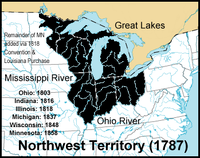Organic act



InUnited States law,anorganic actis anactof theUnited States Congressthat establishes aterritory of the United Statesand specifies how it is to be governed,[1]or anagencyto manage certain federal lands. In the absence of an organic law a territory is classified asunorganized.
The first such act was theNorthwest Ordinance,passed in 1787 by the U.S.Congress of the Confederation(under theArticles of Confederation,predecessor of theUnited States Constitution). The Northwest Ordinance created theNorthwest Territoryin the land west ofPennsylvaniaand northwest of theOhio Riverand set the pattern of development that was followed for all subsequent territories. The Northwest Territory covered more than 260,000 square miles and included all of the modern states ofOhio,Indiana,Illinois,Michigan,Wisconsin,and the northeastern part ofMinnesota.
TheDistrict of Columbia Organic Act of 1801incorporatedWashington, D.C.,and placed it under the exclusive control of theUnited States Congress.
The Organic Act for theTerritory of New Mexicowas part of theCompromise of 1850,passed September 9, 1850. Primarily concerned withslavery,the act organized New Mexico as a territory, with boundaries including the areas now embraced in New Mexico, Arizona, and southern Colorado.
List of organic acts
[edit]Territorial organic acts have included (in chronological order):
- TheNorthwest Ordinance
- TheIndiana TerritoryOrganic Act
- TheDistrict of Columbia Organic Act of 1801
- TheOrganic Act of 1804,with respect to theTerritory of Orleans
- TheMichigan TerritoryOrganic Act (1805)
- TheIllinois TerritoryOrganic Act (1809)
- TheArkansas TerritoryOrganic Act (1819)
- TheOregon Bill of 1848,created theTerritory of Oregon
- TheUtah TerritoryOrganic Act (1850)
- TheNew Mexico TerritoryOrganic Act (1850)
- TheKansas–Nebraska ActcreatedKansas TerritoryandNebraska Territory
- TheColorado Organic Act,1861, created theTerritory of Coloradoout of eastern Utah Territory, western Kansas Territory, southwestern Nebraska Territory, and a small portion of northeastern New Mexico Territory
- TheNevada TerritoryOrganic Act, 1861
- TheDakota Organic Actof 1861
- TheArizona Organic Act,created theTerritory of Arizonain 1863 from western New Mexico Territory
- TheMontana Organic Act,created theTerritory of Montanain 1864
- TheDistrict of Columbia Organic Act of 1871,amalgamated Anacostia, Georgetown and Tenley Town to the City of Washington; and consolidated the County of Washington, City of Washington and District of Columbia into one governmental unit
- TheAct Establishing Yellowstone National Park (1872)
- TheFirst Organic Act for Alaska,1884
- TheOklahoma Organic Actof 1889, established theOklahoma Territory
- TheHawaiian Organic Act,enacted in 1900, established a government for theTerritory of Hawaii
- TheForaker Actor Organic Act of 1900, established civilian government inPuerto Rico.It was superseded in 1917 by theJones–Shafroth Act.
- TheSecond Organic Act for Alaska,1912
- TheOrganic Act of the Virgin Islands of the United Statesof 1936 (Pub. L.74–749,49Stat.1807,enactedJune 22, 1936) established a government for theU.S. Virgin Islands,replacing previous temporary provisions (Pub. L.64–389,39Stat.1132,enactedMarch 3, 1917). It was superseded by theRevised Organic Act of the Virgin Islandsof 1954 (Pub. L.83–517,68Stat.497,enactedJuly 22, 1954).
- TheGuam Organic Act of 1950,codifiedGuamas an unincorporated territory and established civilian government ending Guam's administration by the U.S. Navy.
ThePhilippines:
- ThePhilippine Organic Act (1902),creation of an electedPhilippine Assembly.
- TheJones Law (Philippines),replaced the 1902 act in 1916 and created a fully electedPhilippine Legislature.
Others:
- Organic Act of Feb, 10, 1807, founding the Survey of the Coasts (National Ocean Service)
- Organic Act of 1862, establishing theUnited States Department of Agriculture
- TheNational Park Service Organic Act,establishing theNational Park Serviceand theNational Park Systemin 1916
See also
[edit]References
[edit]- ^"What is ORGANIC ACT? definition of ORGANIC ACT (Black's Law Dictionary)".The Law Dictionary.November 4, 2011.RetrievedAugust 16,2019.
